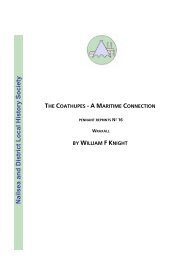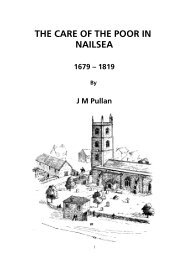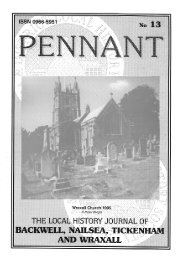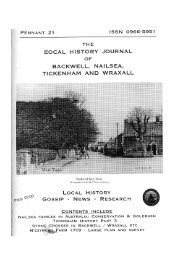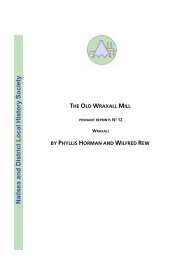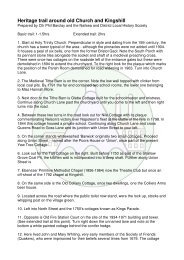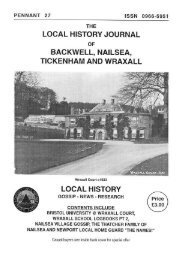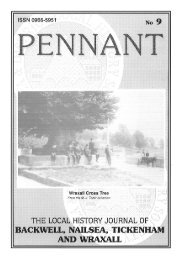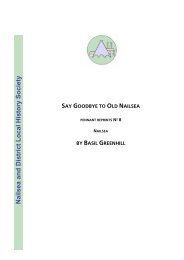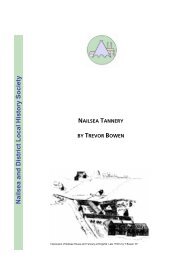Pennant 6 - Nailsea and District Local History Society
Pennant 6 - Nailsea and District Local History Society
Pennant 6 - Nailsea and District Local History Society
You also want an ePaper? Increase the reach of your titles
YUMPU automatically turns print PDFs into web optimized ePapers that Google loves.
Previously published by <strong>Nailsea</strong> & <strong>District</strong> <strong>Local</strong> <strong>History</strong> <strong>Society</strong><br />
during 1994.<br />
This ebook version, © The respective authors <strong>and</strong> <strong>Nailsea</strong> &<br />
<strong>District</strong> <strong>Local</strong> <strong>History</strong> <strong>Society</strong>, PO Box 1089, <strong>Nailsea</strong> BS48 2YP,<br />
has been made available in November 2007, so that an individual<br />
may download <strong>and</strong> read this document, for private research<br />
purposes only. It must not be reproduced or passed to a third<br />
party without written permission of the copyright holders.
A COMPARISON -<br />
BACKWELL PARISH MAGAZINE 1903; PENNANT 1993<br />
(John Brain, the editor of Backwell Parish Magazine (BPM) gave<br />
me a copy of an article from BPM in 1903 (at the end of the first<br />
year of issue). I thought that our readers would welcome the<br />
chance to read the article <strong>and</strong> note the similarities it has with the<br />
position PENNANT, The <strong>Local</strong> <strong>History</strong> Journal of Backwell <strong>Nailsea</strong><br />
Tickenham <strong>and</strong> Wraxall, is in 90 years later. I hope PENNANT<br />
lasts as long <strong>and</strong> as well as has the Parish Magazine. The extracts<br />
from BPM which were written by its Editor the Rev. S Caudwell<br />
are in bold type <strong>and</strong> references to PENNANT are in italics as are<br />
the comments of the editor of <strong>Pennant</strong>.<br />
"It was stated in our last issue that there was cause for<br />
fear that this one-year-old-child the Parish Magazine was<br />
in a very delicate state of health. Much worse might have<br />
been said as is apparent now : it might have been said to<br />
be dying. On consulting our Statement of Accounts given<br />
below, our readers will be shocked <strong>and</strong> horrified to find<br />
that there is a deficit of nearly £12".<br />
[Each copy was 1d (i.e. 1s. [or 5p] per year but contributions of<br />
2s 6d or 5s [25p] were invited. It should be noted that the<br />
population of the parish in 1901 was only 936 <strong>and</strong> even if every<br />
individual had paid 1d per month the total income for one year<br />
could not have exceeded £48. A loss of £12 was therefore<br />
tantamount to a disaster. Apart from the price of a bottle of<br />
Scotch Whiskey (18p) I cannot find other prices for 1903. I have<br />
had more luck with 1914 the year in which World War 1 "The<br />
Great War" began. On November 16th 1984 the Daily Express<br />
referred to a "recent" Commons reply where it was said that 1 in<br />
1914 was then worth 10p. Prices of other items in 1914 were:- A<br />
st<strong>and</strong>ard loaf 3p, a pint of beer 1p <strong>and</strong> postage on a 2oz letter
1p. I have used p notation for the benefit of our younger<br />
readers]<br />
"It is difficult to make any calculations in issuing the first<br />
year’s number of a paper. In this case an estimate was<br />
given by the printer for so many copies: it was soon found<br />
that 40 more were required; then in the next month's issue<br />
10 more, then again ten more <strong>and</strong> so on."<br />
"Another thing to be taken into consideration is that there<br />
is no calculating the amount of subscriptions. They came in<br />
in driblets <strong>and</strong> as people had no idea how much was<br />
required sums were given which would have been largely<br />
increased had they known more."<br />
With <strong>Pennant</strong> the N&DLHS underwrote the first issue <strong>and</strong> I<br />
approached about a hundred people, that I knew, offering them<br />
four copies at £5 on the underst<strong>and</strong>ing that they would pay after<br />
receiving the first edition for examination. It was also agreed that<br />
N&DLHS members would receive a copy as part of their<br />
subscription to the <strong>Society</strong>.<br />
N&DLHS received sufficient support to send the first edition to<br />
print <strong>and</strong> subsequently the N&DLHS agreed to underwrite the<br />
next 3 editions. These were spread over a period of 14 months<br />
rather than one year.<br />
The editor BPM then ponders on the suggestion that those who<br />
came late should have to wait a year <strong>and</strong> not get back numbers<br />
but goes on to say:<br />
"Well what is to be done? Is the magazine to be allowed<br />
to die? I think not, I think that a Parish like Backwell ought<br />
to have magazine, that is for the general good that it<br />
should have one <strong>and</strong> that people for the most part wish it
to continue. Still I should not be justified in incurring such<br />
a debt as £12 every year, but I think this with care may be<br />
avoided".<br />
PENNANT incurred a small loss in its first year but that was in<br />
many ways almost worthwhile in view of the generous<br />
comments N&DLHS received from professional historians who<br />
were kind enough to comment on the first four editions. The<br />
reason for the loss was a simple one in that as stated above it<br />
was decided to supply a copy to each of our members as part of<br />
the their subscription to the <strong>Society</strong>. We still have a few back<br />
numbers <strong>and</strong> when these are sold a small profit overall will be<br />
revealed. This year we have made a slight adjustment to our<br />
subscription fees <strong>and</strong> will deliver a copy of each edition to our<br />
members who indicate that they wish to receive one. At the time<br />
of writing (mid November) we are on target to reach the amount<br />
of income anticipated in our Budget.<br />
The Editor of BPM goes on:<br />
“I propose therefore, to take a bold step <strong>and</strong> go on, being<br />
influenced by the following considerations <strong>and</strong><br />
expectations:-<br />
(1) The printing is not likely to be such a serious item in<br />
the expenditure again. There will be no necessity for<br />
re-printing, <strong>and</strong> the picture of the church <strong>and</strong> the cover<br />
having been once produced will not now cost much in<br />
the re-producing."<br />
N&DLHS made a conscious decision to produce a quality journal<br />
<strong>and</strong> this does of course have an impact on costs. We have had<br />
wonderful support from our printers who have given me many<br />
tips that have improved the journal. Costs are being kept under<br />
review. The content of the journal is intended to be a mixture of<br />
anecdotes, personal memories <strong>and</strong> the results of detailed
esearch. While the latter is difficult to come by we will make<br />
every effort not to become trivial.<br />
(2) I have taken the Advertisements into my own h<strong>and</strong>s.<br />
Before they were let to an Agent <strong>and</strong> produced<br />
practically 1-11-0d, for 9 copies were given free to the<br />
advertisers each month. I hope to make more than this<br />
if I am supported. It means a little extra trouble at the<br />
end of the year, but I am glad to undertake it. Will<br />
anyone wishing to advertise in next year's issue<br />
communicate with me at once.<br />
We tried to obtain advertising from local businesses but in the<br />
recession few were prepared to consider advertising in what was<br />
a limited circulation journal. We have accordingly not attempted<br />
to seek new advertisers for Nos 5 to 8.<br />
(3) Several of the Ladies of the Parish have very kindly<br />
undertaken to be responsible for Social evenings in the<br />
Schoolroom, on the Wednesday evenings in January. If<br />
people will patronise these they will both help the<br />
magazine <strong>and</strong> secure much enjoyment.<br />
(4) I hope the numbers of subscribers will increase <strong>and</strong> that<br />
some will be willing to increase their subscriptions. No<br />
one before had any idea how much was wanted or I<br />
would make bold to say that subscriptions would have<br />
been larger <strong>and</strong> more numerous.<br />
In conclusion I wish to thank Mrs Sully, Miss Chick, <strong>and</strong><br />
Miss Vowles most heartily for their work in being<br />
responsible for the delivery of the Magazines each month.<br />
Their work, though not much noticed is exacting <strong>and</strong> they<br />
deserve the warmest thanks.
My last word is "Play up Backwell for the magazine” The<br />
Editor (BPM)<br />
The last comments are appropriate today. We have 150 copies of<br />
<strong>Pennant</strong> to deliver <strong>and</strong> need to establish an organisation to<br />
ensure their delivery each quarter.<br />
Say Goodbye to Old <strong>Nailsea</strong><br />
by Basil Greenhill<br />
This article was written about 20 years ago <strong>and</strong> was previously<br />
published by <strong>Nailsea</strong> <strong>and</strong> <strong>District</strong> <strong>Local</strong> <strong>History</strong> <strong>Society</strong> c1978 as<br />
the first in a series "The Greenhill Papers". Footnotes have been<br />
added <strong>and</strong> some minor amendments made by the editor.<br />
The Time 1923 or 1924<br />
The single decker open front bus which had brought me via<br />
Backwell turned left a long distance beyond the Great Western<br />
Railway onto, what I found was called, Ashayes or Ashhaze<br />
road. (1) We passed Little <strong>Nailsea</strong> <strong>and</strong> as we entered Old Church<br />
road there was <strong>Nailsea</strong> Field with its one time beer house<br />
st<strong>and</strong>ing well back from the road (2) . Branches of the hedges<br />
scraped both sides of the bus, but of road traffic that morning<br />
there was none except maybe a few semi-scared walkers who<br />
diligently draped themselves in the hawthorn bushes as they<br />
strove, unapprovingly, to accustom themselves to a monster<br />
from a nearby city, an alien in a peaceful l<strong>and</strong>.<br />
The destination of the bus was <strong>Nailsea</strong> Old Church <strong>and</strong> I had<br />
come to see Mr Gallop, the l<strong>and</strong>lord of the Ring O' Bells, where<br />
for centuries (3) good Vestrymen had gathered, each with his own<br />
unlabelled chair or particular place on the settle, each with his
own churchwarden pipe <strong>and</strong> any man of substance with his own<br />
mug for cider or strong ale. There the business of the church <strong>and</strong><br />
parish was discussed at length <strong>and</strong> most likely a policy approved<br />
for the next Parish Council meeting, for the old stalwarts had<br />
been elected at the formation in 1894 <strong>and</strong> some of them had<br />
been on it ever since.<br />
My business quickly finished, for I was a teetotaller, I turned into<br />
Back Lane, with three cottages on the right h<strong>and</strong> side, followed<br />
by a secluded house behind a high wall. The tower of a winding<br />
shaft of Forty Fathom pit (4) , covered with ivy by now, but used as<br />
a pumping shaft for Grace's pit or Sixty Fathom a mile or less<br />
away at the bottom of Engine Lane, which is the beginning, you<br />
may have noticed, of the area known as West End. Incidentally, a<br />
family lived in the engine house of Grace's pit until the 1950s.<br />
What a life!<br />
On the other side of the road to Forty fathom was, <strong>and</strong> is, Goss<br />
Lane, originally called Gorse or Gorsy Lane.<br />
The road from Bristol to the Old Church ran past the Friendship<br />
Inn along Chapel Alley [past the United Reform Church] down<br />
Silver Street, up Union Street <strong>and</strong> Church Lane to Church Barton<br />
<strong>and</strong> Holy Trinity.<br />
According to some old deeds Goss Lane began by Union Street<br />
<strong>and</strong> finished at Silver Street; there was no road from the pit to<br />
the church, but when that portion of the road was made it<br />
became the back lane to the Church <strong>and</strong> logically the whole of<br />
the road was designated Back Lane in the course of time. Years<br />
ago, I have been told, Bristol Water Works took over Forty<br />
fathom pit for the water supply, but this statement I have never<br />
checked.<br />
The allotment field comes next <strong>and</strong> this, Dr White the younger<br />
told me, was let on perpetual lease to the Parish Council so long
as its use as such is continued. It was let to the Council by Dr<br />
White's aunt, or one of them, I understood. Have you ever<br />
noticed the old rifle or carbine butts on the far side, a relic of the<br />
days when <strong>Nailsea</strong> had its own Volunteer Company? At a dip in<br />
the road at the end of the field the local vet lived for many years.<br />
The boundary of the parish of Christ Church comes down the<br />
middle of the road from Silver Street <strong>and</strong> here turns on its way<br />
towards Station Road <strong>and</strong> Lodge Lane.<br />
Not very far from the road, developers found an old coal pit shaft<br />
when building houses on the Mizzymead Estate; it was supposed<br />
to be connected with Forty fathom.<br />
Apart from the exceptions mentioned there were fields on each<br />
side of the lane until one neared Silver Street, where on the<br />
corner lived a retired Army Colonel <strong>and</strong> his daughter a talented<br />
miniaturist. On the left h<strong>and</strong> corner was a windmill <strong>and</strong> a deep<br />
well for supplying water to two large greenhouses belonging to<br />
Mr Bougourd, a florist <strong>and</strong> greengrocer who occupied premises<br />
in Silver Street near to which was once the village club. The<br />
windmill was dismantled in 1921 <strong>and</strong> about three years later the<br />
six semi detached houses were built where the green-houses had<br />
been. The top one became the manual telephone exchange.<br />
Continuing back in the direction of the Church, the first Council<br />
houses were built in 1928, with more later in Orchard Road <strong>and</strong><br />
Ridgway; the last mentioned being named after Mrs Ridge who<br />
lived at one end of the road. Later came private development in<br />
Chancel Close, Trinity Road, Ploughed Paddock <strong>and</strong> Goss Lane,<br />
whilst on the other side, running parallel with the new ring road<br />
- Queens Road- modern council houses were built. This does not<br />
complete the changes, for Meadway Avenue was built down the<br />
line of a brook whose waters run from a spring in the grounds of<br />
<strong>Nailsea</strong> School, <strong>and</strong> opposite Meadway is Greenhill Close, built in<br />
1964,or thereabouts.
After the war a young man finished with the Army <strong>and</strong> set up in<br />
business on what is now the corner of Meadway Avenue as a car<br />
repairer <strong>and</strong> the owner of a hire car. After years of steady<br />
expansion he took a better site in Clevedon road. The name Back<br />
Lane was changed to Whitesfield Road as strangers who came to<br />
live there did not like the seeming denigration. The Parish<br />
Council was reluctant, but the far seeing ones won the day <strong>and</strong><br />
when Mr Cliff Bougourd suggested Whites Field to<br />
commemorate the giver of the allotments, it was approved <strong>and</strong><br />
adopted.<br />
Walking up towards Silver Street, we see, on the opposite side of<br />
the road a monkey puzzle tree (Araucaria) which was much<br />
smaller in 1924, <strong>and</strong> beyond it a stone Maltese cross on an<br />
outbuilding of Orchard House. This was for many years the<br />
residence of Dr White who was a member of, or chairman of,<br />
the Parish Council for many years, <strong>and</strong> presumably the building<br />
noted was his surgery. His gardens <strong>and</strong> fields were extensive. The<br />
kitchen garden, for instance ran westwards from the house to<br />
the back of the bungalows in Camp View, where the high wall<br />
of local stone still remains.<br />
There was a small quarry on the l<strong>and</strong>, which made wall building<br />
much easier. Thin seams of coal run up this side of Silver Street.<br />
There were several shallow shafts, now filled in, <strong>and</strong> years ago I<br />
was told of a local resident who knew of these seams <strong>and</strong> would<br />
descend into the quarry, remove a large stone <strong>and</strong>, no doubt,<br />
with a certain amount of risk, help himself to the coal that was<br />
there for the getting. When Dr White retired from practice he<br />
was given an illuminated address by the Parish Council which<br />
reads as follows:-<br />
To Dr John William White<br />
This testimonial is a recognition of your long service of 50 years<br />
in the village of <strong>Nailsea</strong>, the greater part of which you were the
only Doctor in the Parish, also of the unbroken period of 35<br />
years as Chairman of the Parish Council <strong>and</strong> parish meeting with<br />
the record of not having missed a single meeting. We therefore<br />
say that the best tribute that we can pay you is to put it on<br />
record that you have stuck to your guns like a man <strong>and</strong> deserve<br />
all the credit this meeting <strong>and</strong> the parish can give you now that<br />
you have retired. We earnestly hope that the retirement you<br />
have so richly earned will be spent in peace <strong>and</strong> happiness.<br />
Signed by ten Parish Counsellors, Chairman <strong>and</strong> Clerk, January<br />
1932.<br />
NOTES<br />
(1) Ash Hayes Road as it is now called is rather different to what<br />
Greenhill would have seen in the 1920's. Owen Taylor, who<br />
has lived there for many years tells me that it was widened<br />
when it was tarmacadamed <strong>and</strong> he lost 19 feet from his front<br />
garden. He remembers buses running about every two hours<br />
along Ash Hayes Road to the Church <strong>and</strong> then out to West<br />
End.<br />
(2) This beer house was the "Wheatsheaf". The property is now<br />
known as "Field House". We hope to feature this building in<br />
a future edition of <strong>Pennant</strong>.<br />
(3) Ring O' Bells - The <strong>Nailsea</strong> <strong>and</strong> <strong>District</strong> <strong>Local</strong> <strong>History</strong> <strong>Society</strong><br />
has not been able to find evidence supporting the fact that it<br />
was a place "where for centuries good Vestrymen had<br />
gathered" although this is not to say that there was not a<br />
beerhouse near the church. The cottages on the site of the<br />
Ring O' Bells seem to date from about 1820.<br />
(4) This was sited on the NW corner of the Junction of<br />
Whitesfield Road <strong>and</strong> Queens Road <strong>and</strong> was demolished<br />
c1956.(Ref "<strong>Nailsea</strong> Then <strong>and</strong> Now" David Cains/ Margaret<br />
Thomas 1982)
Bus Accident near Tyntesfield<br />
Mike Tozer has drawn my attention to an accident that took<br />
place just before the declaration of war in 1939. Illustrations are<br />
from the "M J Tozer Collection" <strong>and</strong> are reproduced with<br />
permission.<br />
The Bristol Evening Post dated July 17th (1939) carried the<br />
headline” Mother’s Presence of Mind" "Pushed her children<br />
under the seat" "Six Injured When Bristol-Clevedon Double<br />
Decker Toppled Into Field”<br />
A double decker bus overturned on Saturday evening on its way<br />
from Bristol to Clevedon. No one was seriously hurt. There<br />
were10 passengers in the bus most of them in the lower<br />
compartment. Two ladies were slightly injured <strong>and</strong> suffering<br />
from shock were attended by a doctor <strong>and</strong> then sent to their<br />
homes by car.<br />
Four men were taken to the Bristol General Hospital by Bristol St<br />
John Ambulance for attention to cuts <strong>and</strong> bruises but none were<br />
detained.<br />
They were Mr H Curtin (39) 4 St Gregory Road Horfield Mr E<br />
Talbot (23) 14 Mainsfield Street Bedminster Mr W Davies (21) 12<br />
Mina Road St Werburgh's Mr A Smith (30) 30 Frobisher Road<br />
Knowle West THROUGH HEDGE<br />
The bus was travelling from Bristol to Clevedon in the evening at<br />
about 7 o'clock <strong>and</strong> it was just after leaving Weston-super-Mare<br />
road <strong>and</strong> was proceeding towards Wraxall when the accident<br />
happened. A passenger said "There was no other traffic in sight<br />
<strong>and</strong> the bus was going no more than ten miles an hour when it<br />
lurched over <strong>and</strong> swerved to the left”
It is thought that something went wrong with its steering. The<br />
bus cut through a four foot hedge <strong>and</strong> some iron railings <strong>and</strong> fell<br />
on its side into a meadow about six feet below the level of the<br />
road.<br />
Passing cars came quickly to a halt <strong>and</strong> soon there was a long<br />
line st<strong>and</strong>ing in the roadway. Police <strong>and</strong> St John Ambulance men<br />
were quickly on the spot to attend to the injured <strong>and</strong> remove<br />
them to hospital <strong>and</strong> then Bristol Tramways Company engineers<br />
set about the task of getting the bus on to its wheels again to<br />
tow it out of the field.<br />
A <strong>Nailsea</strong> lady showed remarkable presence of mind. She was<br />
Mrs T White of 4 Woodside Terrace who was going home with<br />
three of her children. As the bus was lurching she grasped her<br />
children - three girls Marjorie (10 years old) Maisie (9) <strong>and</strong> Joan<br />
(6) - <strong>and</strong> pulled them as well as possible under the seat.<br />
With the exception of Joan who was bruised down her back they<br />
escaped injury; but Mrs White was thrown <strong>and</strong> received a cut<br />
knee <strong>and</strong> forehead <strong>and</strong> also cut the back of her head <strong>and</strong> neck.<br />
With her children she returned to <strong>Nailsea</strong> on the next bus <strong>and</strong><br />
was attended at home by her doctor.<br />
The driver F Voicey Hepburn Road Stokes Croft Bristol suffered<br />
from shock <strong>and</strong> was taken home. The conductor F Park Brighton<br />
Road Redl<strong>and</strong> Bristol escaped injury <strong>and</strong> assisted the passengers<br />
in getting out of the bus. Two other passengers Mrs Richie <strong>and</strong><br />
Mrs Shaw visitors to Clevedon were taken back to their residence<br />
suffering from shock. An A.A. patrol J Warry rendered first aid<br />
until the arrival of Dr R Jackson, West Town Backwell <strong>and</strong> the St<br />
John Ambulance Brigade.<br />
So ends the article but it is interesting to note that the adjacent<br />
column covers the demise of the tram routes on the Centre -<br />
Durdham Down <strong>and</strong> Centre - Filton routes.
The Baves of Barrow Court, Tickenham<br />
by David Chappell<br />
Samuel Bauf was born in Cologne in 1588. He went to Paris<br />
where he qualified as a Bachelor of Medicine. While there he had<br />
become known to the English ambassador, Sir Thomas Edmunds,<br />
<strong>and</strong> he came to Engl<strong>and</strong> with Thomas's young son, Henry<br />
Edmunds. Both Bave, as he had now become, <strong>and</strong> young<br />
Edmunds (who was only 15 - modern whiz kids please note)<br />
matriculated at Christ Church, Oxford on16th December 1620.<br />
Samuel Bave now not only acted as tutor to Edmunds, but also<br />
qualified as a doctor of physic in 1628. He became a naturalised<br />
citizen the next year <strong>and</strong> was thus able to practice in Engl<strong>and</strong>;<br />
<strong>and</strong> indeed did so, firstly in Gloucester <strong>and</strong> then in Bath until his<br />
death in 1688.<br />
While in Gloucester he met <strong>and</strong> married Hester Robinson<br />
daughter of a Gloucester lawyer <strong>and</strong> alderman. They had eight<br />
children of whom Anthony is of most local interest. While by his<br />
father’s will Anthony inherited the first advowsons of<br />
Chalercombe <strong>and</strong> Swainswicke (together with two feather beds -<br />
not uncommon <strong>and</strong>, as others also got two feather beds, this<br />
seemed the norm for the family), more importantly he also<br />
inherited the manor of Barrow Court, which his father had<br />
bought in 1656 but apparently did not live in.<br />
Anthony (also an Oxford graduate) was Vicar of Tickenham for a<br />
period from 1666, after which when he moved on to Twerton.<br />
He <strong>and</strong> his wife had one child Samuel, who was born in 1672<br />
the year before his father's death.<br />
This Samuel - (II for necessary convenience) by his first wife<br />
Rebekah had one child, Dr Anthony Bave, who died in 1737<br />
aged 39 <strong>and</strong> without children. By his second wife, Elizabeth, he
had only a daughter. She was known as Maria <strong>and</strong> married<br />
Reuben Hollyman. By his third wife, Elizabeth Webb, he had a<br />
son Samuel (III). But Samuel III at the age of 15 died of smallpox<br />
in 1735 <strong>and</strong> is buried under a prominent slate stone in what is<br />
often called the Bave Chapel in Tickenham Church.<br />
Thus after the death two years later of Dr Anthony Bave in<br />
1737it was obvious that this Bave line was ended. This may have<br />
prompted Samuel III's now widowed "inconsolable <strong>and</strong><br />
affectionate mother" (as is recorded on it) to have erected to his<br />
memory -with space for others - the monument in the church<br />
known as The Bave Memorial. This is the only monument of its<br />
type or age in the church <strong>and</strong> was made by a Bristol architect<br />
Michael Sidnell, <strong>and</strong> probably dates from around 1740.<br />
Recent years have not been kind to the monument. Eventually,<br />
in1986, the Wells Conservation Centre reported:-<br />
"The state of the monument is perilous - some elements have<br />
already been removed or fallen off.<br />
Some of the iron cramps have disintegrated with rust which has<br />
also stained the marble. There are signs of movement within the<br />
elements (when eventually dismantled the jig saw consisted of<br />
54pieces <strong>and</strong> was not <strong>and</strong> is not complete). Further there is<br />
evidence of thinner sections of marble being distorted due to the<br />
action of water soluble salts" (there being no equivalent to a<br />
modern damp course).<br />
It was hardly surprising then that the archdeacon readily gave<br />
authority for the monument to be taken down.<br />
The estimate for its restoration was well over £2000 <strong>and</strong> the<br />
small parish having already paid to have the monument made<br />
safe was distressed to find that in spite of a plea by "Moorman"<br />
of the Mercury (it was the last piece he wrote) the public was not
interested. The parish therefore had to lower its sights <strong>and</strong> the St<br />
Andrew's Trust paid for it to be repaired which, while not being<br />
the same thing, was a generous <strong>and</strong> saving gesture.<br />
Meanwhile there was an interesting hiccup in that when the<br />
monument was taken down the original Elizabethan plaster, over<br />
which it had been mounted <strong>and</strong>, as part of "Victorian”<br />
improvements, had been removed from the rest of the church<br />
was now revealed as being in a pretty parlous state. There were<br />
however a few isolated letters in black Gothic script probably<br />
part of the Magnificat which is commonly found in lady chapels<br />
which, of course, this was. It was this connection which moved<br />
the ladies of Tickenham to find the VAT to match the Trust<br />
grant.<br />
That plasterwork was secured <strong>and</strong> the monument re-erected in<br />
midsummer 1991 but not before it had been subjected to an<br />
unnecessary trip to Wells (due to a communication failure) in the<br />
back of an open truck in the rain which further damaged the<br />
inscription. The detail can fortunately still be read - but awaits<br />
restoration. Altogether a rather sad tale <strong>and</strong> one that is perhaps<br />
not yet ended.<br />
Sources<br />
Poynton: The Baves of Bath <strong>and</strong> Barrow Court 1895<br />
Byrchmore: Parochial <strong>History</strong> of Tickenham
A Wraxall Curse<br />
by Phyllis Horman<br />
Until a few years ago a piece of hedge a few feet long stood in<br />
the "wheat field" opposite the building which was the boys’<br />
school. This hedge was supposed to represent the bottom of the<br />
garden of a cottage which stood a little further up. The story was<br />
told that a Rector wanted an old lady out of the cottage so that<br />
it could be pulled down. Before she went she put a curse on the<br />
hedge saying that it would st<strong>and</strong> for ever to remind people that<br />
her cottage had once stood there.<br />
The hedge remained despite various attempts to clear it <strong>and</strong> it is<br />
only in the last few years that one assumes that the curse wore<br />
off <strong>and</strong> the hedge succumbed.<br />
We do not know when the cottage was destroyed, maybe it was<br />
at the time of enclosure or when the woods were planted both<br />
events occurred about the time of Waterloo 1815.



